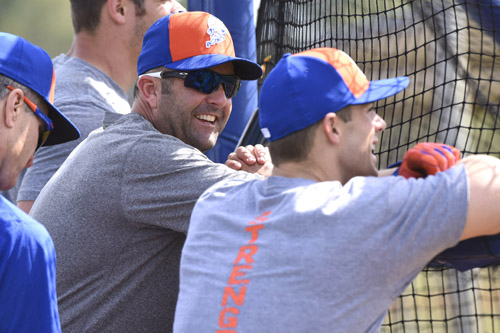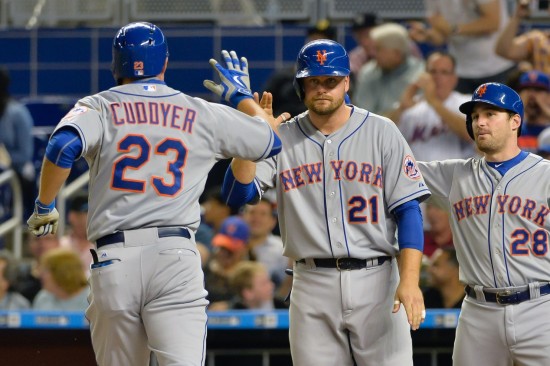
Exit velocity reminds me of a roommate I had who once decided to chase a full turkey dinner with a Domino’s Hawaiian and a six-pack. He was in a recliner across the room making gurgling noises. I look up and realize the noises were coming from his belly, which was moving — on it’s own, like an alien was trying to claw it’s way out. He tried to sit up but nope, not happening. So he pulls the little upright lever and bah-whoosh a stream of stomach contents unfolds like a giant colorful gravity-defying umbrella and floats in mid-air for a split second, descending slowly onto a static unsuspecting room. The exit velocity of the pizza chunks had to be between 60 and 70 mph easy.
Exit velocity is now apparently a thing in baseball and it doesn’t have anything to do with that third chili slathered jalapeno-cheddar bratwurst you had at the ballpark last weekend. It also shouldn’t be confused with escape velocity, which is a threshold reached by rockets escaping earth’s gravitational pull and audiences at Adam Sandler movies. As I understand it, some magnificent numbers bastard decided to turn a radar gun on balls coming off of bats and voila a new statistical category is born … because really, we don’t have enough of those.
That’s right baseball fans, we’ve reached a gasping summit in the marriage of technology and numbers which allows us to draw breathtaking conclusions. For instance, the increased probability of a hit when exit velocity is higher. Apparently hitting a ball hard results in more hits not less … It’s like listening to a radar Tim McCarver …
“To induce ground balls, throw the ball outside, not inside.”
“Higher exit velocity results in a greater likelihood of producing a hit, particularly if the ball isn’t hit right at someone.”
“The way to avoid hitting the ball to the left is to go right! Or up the middle! You could also strike out and thus not hit the ball in any direction!”
(By the way two of the above three are actual T. McCarver quotes …)
Clearly, modern technology and modern statistics have changed the game. Used to be teams were built on scouting, word of mouth, even news clippings … Bobby can get on base and Jack’s got terrific command and Freddy’s got prodigious power, so on and so forth. You had to have the right mix in a winning locker room, maybe a bunch of raw kids and some solid veterans, maybe an elder-statesman and a couple of loonies to break the tension – and you needed power, speed, the ability to catch and throw … with make-up always a consideration.

You hear a lot of talk about how it’s talent that wins, but I’ll take tough talented any day over genteel talented and It’s not just the 86 Mets that left me with that impression. The Reds were tough as hell when I was a kid, and how about the Pirates of the early 70’s? Remember Doc Ellis beaning 3, 4 guys in a row? Throwing a no-hitter on LSD? It’s like the movie Major League where you had this baseball melting-pot … some grit, some voodoo, speed and power, some sage leadership, and a healthy dose of crazy. These days, sadly, I almost get the feeling teams are assembled strictly by the numbers.
The Nats and the Mets, two of the better teams in their division, are both weirdly unbalanced. The Mets are ridiculously lopsided on the pitching end and conspicuously lacking in team speed, while the Nats (as well as the Mets really) have a glaring Achilles heel in team defense and not much speed themselves. In years past both teams would have taken steps to address these shortcomings in an effort to be “balanced,” but balance is out the window these days in favor of power, power pitching, and getting on base. Why? Because the numbers say so.
Monday night’s 2–1 Mets Cardinals contest offered a fascinating treatise on league trends. The Cards stick to what’s always worked for them — a gritty hard-scrabble pitch well, run the bases, steal, hit-and-run, move-em-over-and-get-em-in philosophy, small ball … The 2015 Mets on the other hand are almost machine like. They beat you … because the numbers dictate they should beat you.
So you can hit-and-run and bunt to your heart’s content with your gritty characters, but against these Mets none of that matters. You punch in a slew of pitching and hitting metrics and the computer spits out a score in your favor. Isn’t that how it works?
All that matters is that these Mets have the right x-FIP and just enough OPS+ to scrape enough runs together relative to how many they allow. Inspiring isn’t it? It’s like communism, like getting beaten by the Borg collective. Players are drones, interchangeable, representing little more than their numerical contributions to this grand Aldersonian amalgam. In the end, if your Pythagorean run-differential is in your favor you’ve won, or you should have won, which is just as good. Individual stats be damned … Personalities? Pfffft … Wins? Insignificant artifacts of a winning formula. In the end all that matters is how much grain the collective can harvest …
The preponderance of insane shifts are the latest wrinkle in our pastime proliferating from this sabermetric cacophony. Presumably if you run enough simulations and analyze enough spray-charts your fielders will hardly have to move at all. Then you can just focus on finding big lumbering traffic cones who can hit the ball 500 feet.
In the 9th inning on Monday with Familia on the mound the Cards employed the quintessential small-ball play … a perfectly executed hit and run. On the next play the game was tied. Earlier in the 4th Lucas Duda drove in Curtis Granderson on a ground ball that just slipped by to the left of the Cardinal shift. I was thrilled to see him take advantage it, I even re-tweeted it:
Pinpoint accuracy. pic.twitter.com/WnYzrVugWH
— MLB GIFS (@MLBGIFs) May 19, 2015
… But then in the 7th and again in the 12th Duda played right into the shift grounding out to the right side. I don’t know, somehow it bothers me when the computers win … makes me want to blow pineapple chunks into the mainframe. But it doesn’t matter … so what if Duda hit a few to the left side, these days all that matters is what the numbers tell us matters …
If I were managing the Mets I’d equip a batting cage with a big chain link barrier about 15 feet or so from the plate blocking the entire right side of the infield, and I’d fire inside fastballs at Granderson and Duda while blasting Rage Against The Machine … Want a hit? Slap it to the opposite field DUDA. If a guy named Moustakas can do it I’m sure these guys can.
I looked at a stat the other day that showed how Mets pitching had the 4th lowest hard hit ball rate in the league. Turns out when a pitcher induces weak contact (low exit velocity) the chances of registering an out go up. That coupled with a very low walk rate kept Mets starters’ ERA at under 3.00 (prior to last night) which was good for best in the majors. It’s so good in fact, it wouldn’t be far-fetched to conclude that 3 runs or more should bag you a win more often than not. Now I also saw on twitter the other morning that we “out-hard-hit” (I guess that’s also a thing now?) the Cubs during our 4 game set in Chicago, and that, again, we should presumably win more often than not when that happens.
But here’s the thing, Baseball isn’t played by computers or Borg hybrids … it’s played by humans, and humans don’t always follow the printout. Sometimes even Pavlov’s dogs don’t drool, sometimes Duda will slap one to the left side, and sometimes the 2014 Nats will lose to the 2014 Giants because the Giants play better baseball.
In the end we might want to consider Bernoulli’s principle — that broadening the walls of a fluid channel reduces pressure at it’s widened boundaries thereby increasing the fluid’s velocity at the opening. So a river that broadens will experience an acceleration at the widening — a rush to the path of least resistance. It’s similar to how the relatively higher pressure inside my friend’s stomach compelled its contents through his esophagus to the lower resistance of all over the carpet and coffee table.
It’s not easy to hit a ball 470 feet into a camera well. There are two or three guys on the planet who can do that sort of thing. On the other hand I know some 12 year olds who might be able to put a bat in front of a ball and bunt to the left side of an infield … path of least resistance.
The Nats in last years NLCS (and the Mets in 2006) were beaten by teams with better fundamentals. Baseball has reverted to a level where offense is so scarce, every run matters. Alderson broke into the game at a time when .900 OPS players were becoming commonplace and .800 OPS players were a dime a dozen. No one had time for this boring hit-and-run nonsense when you could just wait for a 3-run blast and enjoy watching your girlfriend jump around. Those days are gone.
Alderson got part of it right. He built a beastly monster mash of pitching depth … but the other part, the small ball part, not so much.
The Mets didn’t win on Monday because they had a better stats team, they won because a guy with a big heart and a big arm shut down the opposition. On Tuesday, however, the Cards won because in addition to out-pitching the Mets, they scored 10 runs in what seemed like 10 different ways.
The Mets would do well to look into diversifying their own portfolio … securing some athleticism, some speed, and a few more ways of manufacturing runs, because clearly putting all their eggs into the bring-the-fences-in-and-wait-for-the-3-run-blast basket isn’t working.















